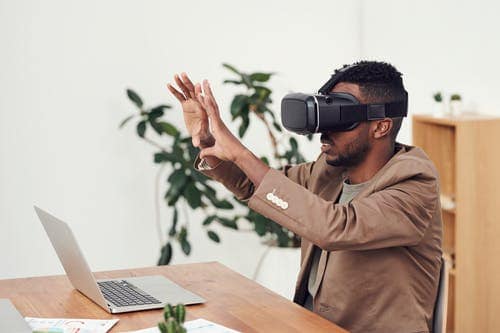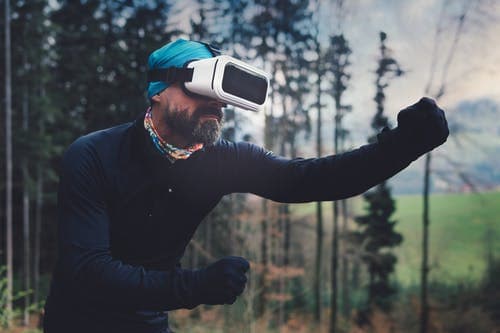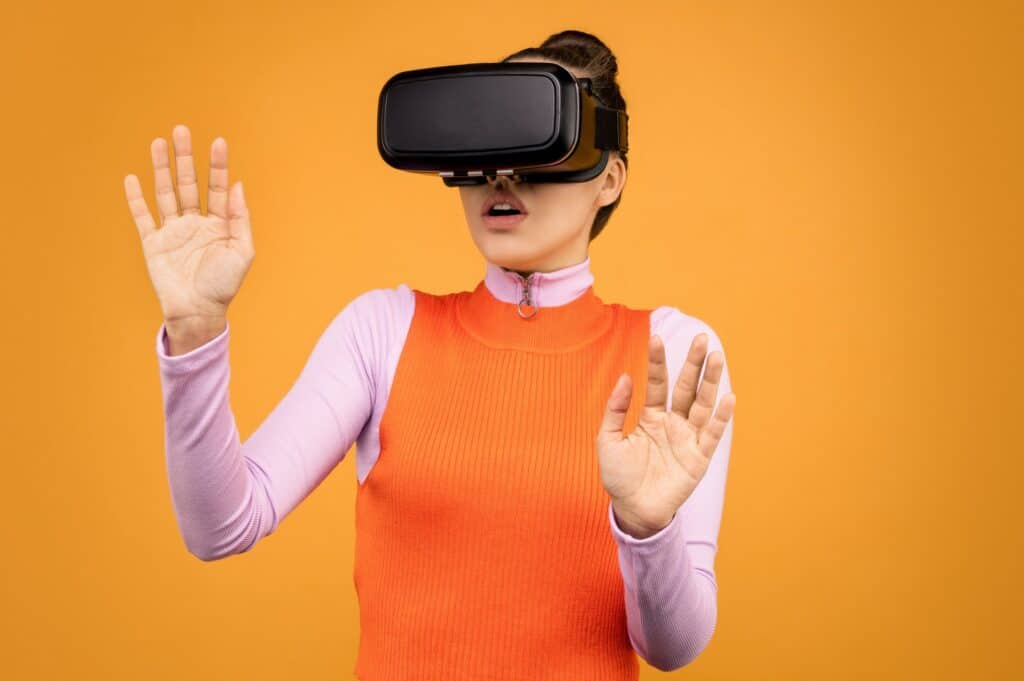VR
Virtual reality is the use of computer technology to create a simulated environment (VR). Virtual reality, in contrast to traditional user interfaces, immerses the user in an experience. Instead of staring at a computer, users are immersed and able to interact with 3D environments.
By reproducing as many senses as possible, including vision, hearing, touch, and even smell, the computer is transformed into a gatekeeper to this fake world. Near-real VR experiences are only limited by the availability of content and low-cost computing power.

Virtual Reality’s most readily recognizable component is the head-mounted display (HMD). Humans are visual creatures, thus the display technology that distinguishes immersive Virtual Reality systems from traditional user interfaces is often the most important differentiation.
For example, CAVE automated virtual environments actively project virtual content into room-sized monitors. Consumer and industrial wearables are the wild west, while they’re enjoyable for individuals at colleges and huge labs.
Virtual Reality apps that are convincing require more than simple visuals. A person’s perception of space is based on both hearing and vision. In fact, humans react to aural signals faster than they do to visual cues. Accurate ambient noises and spatial qualities are required to produce completely realistic Virtual Reality experiences.
These give a virtual environment a strong sensation of presence. Put on some headphones and play around with this audio infographic from The Verge to get a sense of the binaural audio elements that go into a Virtual Reality experience.
Companies Focusing on VR
Virtual reality startups are unquestionably thriving. However, some VR firms are in a far better situation than others. Virtual reality firms must face a harsh reality: VR is one of those computer concepts that has always been far ahead of current technology’s capabilities. The concept was sound, but the necessary hardware and software were lacking to make it a true reality or at the very least a plausible one.
Those same virtual reality firms might be in for some very good news this year: technology may finally make a breakthrough this year. Hundreds of millions of dollars are being spent on R&D by dozens of hardware and software firms to develop a virtual reality that is realistic and does not make you nauseated when you use it, which is a typical side effect of VR headsets.
Let’s have a look at some of the most innovative virtual reality startups.
1. Oculus
Oculus is a Facebook-owned company that is widely regarded as one of the pioneers of virtual reality. They produce virtual reality headsets, which were used in many of the initial VR programs. Oculus also creates virtual reality programs and games. They’ve been one of the most popular businesses mentioned by gaming YouTubers since they originally piqued people’s curiosity.
With all of the new VR titles, VR received a lot of positive feedback from the gaming community. When YouTubers first started exploring virtual reality, the finest Oculus Quest 2 games were all the rage. Along with the new shows, there were also remakes of legendary programs. What’s even better is that these games are simply coming.
Many VR games have acquired popularity as a result of this virtual reality startup, including Beat Saber, VR Chat, and Job Simulator. One of the earliest shows to pique the public’s interest in virtual reality was this one. This brand is rather young, having launched in 2014. Despite the fact that they are a young business, they were one of the first to assist establish virtual reality as a solid basis.
2. Google
It’s difficult to discuss technology without mentioning Google, the monster that it is. Google has always been on the cutting edge of technology and creativity. Google is a massive corporation with a unique approach to virtual reality and augmented reality. These notions have previously been used by Google in their well-known applications such as Google Maps and Google Search. These apps allow users to be steered in the appropriate route by huge holographic signage.
In Google Search, augmented reality provides consumers with extra information about a given subject. When you’re wanting to learn more about an animal and words don’t quite create the right picture, this might come in handy.
They’re not only incorporating AR and VR into their existing popular services, but they’re also making their own headgear. Google Cardboard is said to be a simple device that transforms your smartphone into a virtual reality projector.
3. iTechArt
iTechArt takes pride in its unique Augmented Reality and Virtual Reality software creation. iTechArt empowers users to make the most of virtual reality and augmented reality by giving them the tools to create whatever they want.
iTechArt doesn’t only provide consumers the tools to produce whatever they want using virtual reality. iTechArt is also known for its excellent customer service. They’re a business that educates customers on how to get the most out of their services.
This is accomplished through their virtual reality software, which teaches users how to utilize their VR programs to play, explore, and create. iTechArt is also notable for allowing users to use a variety of devices, making it cross-platform because 360 videos are supported.
4. Unity
For the past 16 years, Unity has been responsible for creating immersive and high-quality games. Assassin’s Creed: Identity, Satellite Reign, Escape plan, Temple Run Trilogy, Rust, Battlestar Galactica Online is just some of their many popular titles.
It’s no surprise that they’ve branched out into virtual reality, given their reputation for generating high-quality games. Unity, like other Virtual Reality businesses, allows users to create high-quality and immersive virtual reality applications.
Unity not only allows but also encourages such developments by offering Unity Learn to creators. To assist artists to refine their talents, Unity Learn offers live sessions and over 750 hours of videos. People may also submit their work and have Unity look it over for potential.
5. Samsung
Yes, the same firm that manufactures televisions, phones, and even appliances for the house. Samsung’s contributions to virtual reality may not be well recognized, but they have aided the growth of the technology.
Samsung created headgear that allowed more individuals to try virtual reality for the first time. They assisted in the development of VR programs and other applications in addition to producing headsets. The business, which is most known for contending with Apple in the phone market, will always be known as a major virtual reality player.
6. Magic Leap
This is the newest firm, having been created in 2010. Despite the fact that they began 2010 as a startup, they have begun to establish a reputation for themselves. Magic Leap’s principles and ideas may not be well known to the general public, yet they might very well represent the future of education and healthcare. They give doctors surgery simulator training.
These work in the same way as flying simulators do for pilots in training, except they’re for physicians. This permits individuals in training to get experience without risking the lives of others. In certain circumstances, these algorithms do better in terms of teaching than a messy human body since they can investigate things more thoroughly.
7. Firsthand Technology
This may not be a billion-dollar firm, but it might be one of the most influential in VR because of its strategy. Firsthand Technology is a pioneer in the use of virtual reality in healthcare. Education, training, business, research, and rehabilitation are all areas of interest for this firm. The fact that it is a virtual reality firm that isn’t focused on gaming or recreation demonstrates its distinctiveness.
Virtual reality is used by Firsthand Technology to assist patients to relax and exciting during therapy. This demonstrates another side of virtual reality that does not include shooting or playing games. It demonstrates the serious and beneficial aspects of virtual reality.
Current use of VR
Virtual reality is gaining traction in every industry. Finances Online did research to see which industries utilize virtual reality the most. In the future of virtual reality, the way humans entertain, treat, travel, study, interact, buy things, and work will never be the same thanks to this technology.
According to eMarketer, the number of VR users in the United States is $57.4 million in 2020. In 2020, investments in VR and AR are expected to total $915 million (Superdata, 2020). 91% of companies are using or intend to use virtual reality or augmented reality technologies (TechRepublic, 2020).
1. VR in Education and Training
Virtual reality’s key objective in education and training is to make it as effective as it is engaging and to improve people’s learning habits. A big number of startups and established education enterprises have been delivering bundled experiences and services aimed at schools.
Virtual education is currently popular in K-12, higher education, and vocational training, and it will become increasingly more popular as virtual reality advances. VR applications in higher education, which are expected to receive a greater revenue share, include student recruiting, immersive learning, and fundraising.
Medical students who have had the chance to be educated using virtual reality may do some treatments faster and more precisely than their counterparts who have been trained using traditional means, according to a Harward company research. Virtual reality apps, such as those that simulate driving in congested city traffic, help people prepare for real-world driving by offering foundational information and experiences.
2. VR in Healthcare
Care, particularly emergency medicine, is not a place where mistakes are tolerated. Medical workers may acquire all necessary skills and train every technique with a realistic simulation of every emergency situation, from CPR to lumbar punctures, once they are placed in a lifelike VR setting. In addition to realistic visuals, this training can include software that assesses the training’s performance, flags any errors, and provides recommendations on how to prevent them in the future.
Virtual reality in healthcare also includes mental health therapy and illness awareness. Virtual reality’s capacity to immerse a person in any situation through controlled simulation makes it an effective tool for physical and psychological treatment, as well as pain management. VR is already being used by therapists to treat PTSD, anxiety, and phobias.
Virtual reality aids in the rehabilitation of people who have suffered strokes, brain injuries, or other types of trauma. The gamification of the process plays a part here, as it encourages the patient to stay focused and places them in a familiar setting with routines like driving, cooking, or other activities, helping them to swiftly regain motor capabilities.

3. VR in Gaming
It’s pointless to deny that gaming is likely the first thing that the ordinary person identifies with virtual reality’s future. It’s hardly unexpected, given how quickly the virtual reality game business is expanding.
COVID-19, on the other hand, has affected the present position of virtual reality technology in gaming, since it keeps prospective customers at home, making them more likely to engage in games, which is a benefit for the business.
The concepts accomplished in the gaming industry using virtual reality are sometimes far more engaging with their fantasy and advancement than those realized in other industries. It is for this reason that analysts believe VR has the most promise in the game sector.
Future of VR
1. Virtual Reality Empowered with Artificial Intelligence
Virtual reality’s future is set to merge with AI, and the fact is that this is unavoidable. This fusion has already been shown to be advantageous in the corporate world in a variety of ways, such as increasing productivity and optimizing workflows, but developers and researchers are searching for new methods to make it even more beneficial.
First and foremost, development tools should be optimized to design, produce, and compute items faster, as well as process optimization so that VR technology operates better on less powerful hardware.
Another advantage of AI for VR is that it allows us to construct systems that will automatically produce the many items needed for the development of VR apps, making the entire process cheaper and faster. Experts believe that this will lead to the creation of highly interactive workplaces and powerful picture recognition systems in the future.
2. VR in Online Conferences and Sport Events
The use of technology to produce more immersive events and athletic encounters is becoming increasingly popular in the area of VR and AR. As a result of the COVID-19 epidemic, authorities have had to postpone online conferences and athletic events. As a result, major sports organizations and events are investing in virtual and augmented reality to advertise their sports and activities.
Technology allows sports fans to participate in the game even if they are physically on the other side of the planet. This entails holding virtual yet immersive meetings and events in addition to traditional video meetings.
On the road to 2025, the greatest virtual reality technology will immerse and engage fans in games, as well as workers and partners in meetings and events. Also, keep in mind that you will always have the greatest seats!
3. Increasing Adoption in Remote Education and Training
Teslasuit, for example, already employs a full-body suit to deliver deep, immersive haptic feedback, improving immersion through the sense of touch. It also has biometric sensors that can detect a heartbeat, perspiration, and other stress signs. With performance monitoring and feeling, this outfit is meant to imitate the experience and speed VR training.
The Teslasuit is a powerful XR training tool that is currently being utilized in NASA astronaut training, but its potential is boundless. Of course, such equipment is now somewhat expensive, but as technology advances, it should become increasingly inexpensive.
Because to COVID-19, virtual reality technology is rapidly being used in education and training through online learning systems. Companies including Facebook, HTC, and the European Commission utilize the Engage platform for distance learning.
4. Entertainment Empowered with VR
We’ve already discussed some of the non-gaming applications of VR technology, but analysts anticipate that gaming will be the most profitable. Global gaming income is likely to reach about $50 billion by 2026 or 2027, according to the latest estimates. Games, for their part, do not lag behind, with creators creating ever-evolving entertainment technologies to delight players and entice them to purchase new items.
Virtual reality technology is set to open up a whole new realm of entertainment, allowing the entertainment industry to reach new heights and reach new audiences. You may attend world-famous concerts, watch Oscar-nominated films, and sit next to late-night talk show hosts like Jimmy Fallon by just donning a live-streaming headset. Virtual reality has also been incorporated into the iconic TV program Game of Thrones.
Another example of VR entertainment is Google Expeditions. Exploratory information on history, science, and art are included in these voyages. You may use this technology to look at everything from dinosaurs in their natural habitat to Renaissance painting details.
5. VR in Marketing and Advertising
Businesses will have more advertising chances as virtual reality technology becomes more widely used and integrated into everyday life. Businesses have a better chance of reaching potential customers on their way to the future of VR technology, and the ability to target their advertising to the right niche and clientele, as consumers spend more and more time on their smartphones or computers, and this technology is increasingly used.
Virtual reality technology allows you to provide your audience with an entirely new experience. You may effortlessly and interactively incorporate information into standard VR content (for example, product placement), assess people’s reactions to your product, and make better data-driven improvement decisions.
Future of VR in Gaming
Virtual reality (VR) is a hot topic on the Internet right now, and it has a bright future in the immersive experience technology sector. Although virtual reality will never totally replace conventional types of entertainment, it has made the gaming business more accessible and appealing to customers.
Entertainment costs a lot of money for users. This is especially true when it comes to video games. VR-based entertainment has grown in popularity as a result of revolutionary technology in the gaming industry. According to Statista, income from virtual reality gaming in the United States alone is expected to reach $19.5 billion by the end of 2025.
Every new technology is being used by game designers to ensure that their clients get a unique experience each time they play. VR was formerly considered science fiction, but advances in technology have made it a viable choice for game producers. It’s taken the gaming world by storm, and it’s revolutionized the way games are made.
What is a virtual reality casino?
You may wind up generalizing things if you are unfamiliar with casino games. However, there are two types of casinos. There are two types of casinos: real money and amusement casinos. Real money casinos allow users to wager real money on real casino games in order to win cash.
Entertainment casinos, on the other hand, enable players to enjoy their gaming experience without worrying about whether or not they will win money. Other improvements, such as the transition from 2D to 3D game technology, are notable technological advancements that have triggered realism in the gaming industry.
Even if the classic casino experience is progressively fading, you may still have the same fun by wearing VR headsets that are compatible with your gaming device. Make sure your gaming device can connect to the platform you require. You may enjoy an interactive gaming experience with the VR headset.
Benefits VR-driven applications in gaming
Most computer games may be effectively converted into virtual reality (VR) format, resulting in a new and more pleasurable interaction:
1. Increased user involvement
They appear to be more enticing to frequent and occasional gamers who want an immersive experience. When compared to flat-screen games, VR gamers are more engaged because they have a variety of tools at their disposal, such as hand controllers and a headset.
2. Cutting-edge features that enhance the gaming experience
The emergence of controllers was a watershed moment in the development of player interaction in virtual reality environments. Players may now take control of the gaming environment at their leisure. Also, we should expect virtual reality technology to progress beyond simply putting on a headset for a visual experience to offering completely immersive experiences that combine all of the human senses in the near future.
3. Content has been expanded
Virtual reality (VR) is a new enhancing element in the creation of game content. VR has altered genres like as shooters, adventures, and simulations.
Adventure and racing games will be the most popular VR gaming genres in 2020, according to Statista. VR racing games piqued the curiosity of 48 percent of players, while adventure VR games piqued the interest of 73 percent.
Types of VR games
Virtual reality is changing the way we conceive space and interact with it in games as a new medium.
1. First-person VR shooter games
They are the most popular type of virtual reality game. The visual and auditory special effects, as well as everything that happens on the playing field, are felt by the players. Reloading firearms, natural noises, flying bullets, storms, other players’ conversations, strokes, steps, falls, traffic, and so on all have a believable feel to them. The only remaining difficulty for shooter games is the limitation of freedom of movement.
2. Virtual reality racing games
Virtual reality racing games vary from traditional racing games in that players are not constrained in their movement. Virtual reality racing games are usually built on cutting-edge visuals.
3. Horror games
They’re also one of the most popular kinds of video games. Because the visuals are so realistic, it’s more difficult to play in.

4. Virtual reality adventure games
While some players may be put off by more frenetic action games, virtual reality is ideal for a more leisurely pace of exploration and puzzle-solving in adventure games.
5. City-building games
The city-building games take advantage of virtual reality’s amazing prospects to provide whole new gaming experiences and interactive dynamics to the classic city-building game. It allows users to find fresh vistas and see cities in ways they never have before. It allows players to walk around the streets like a giant, watch architecture from afar, zoom in to the ground or out to the air, develop new cities, alter the lighting and weather, and shoot photos of the most amazing city vistas they come across on their own.
Interactive software and hardware are utilized to allow VR devices in the gaming business. You may wander around the artificial environment and explore or control VR games by moving your body. The variety of devices available today allows you to choose how you want to engage with virtual reality. HTC, Google, Microsoft, Samsung, Facebook, Sony, and other technology behemoths have all contributed to the industry’s growth by releasing their own virtual reality headsets that give an immersive gaming experience.
Virtual reality gaming is one of the businesses where technological advancements have propelled it to new heights. In every way, the concepts used in virtual reality games are exciting and spectacular. The advent of virtual reality technology has opened up new possibilities for improving the player’s relationship.
Most computer games will take a long time to fully transition into VR format, but it is reasonable to expect that it will become ubiquitous one day. If you have an idea on how to use VR/AR in gaming or any other sector, the Onix team can assist you. We’ll work together to bring your ideas to reality.

3 thoughts on “Virtual Reality Current Situation and Possible Future for VR”